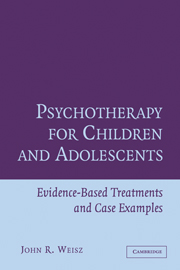Book contents
- Frontmatter
- Contents
- Preface
- SECTION A GENERAL INTRODUCTION
- SECTION B TREATMENTS FOR FEARS AND ANXIETY
- SECTION C TREATMENTS FOR DEPRESSION
- SECTION D TREATMENTS FOR ATTENTION DEFICIT/HYPERACTIVITY DISORDER
- SECTION E TREATMENTS FOR CONDUCT PROBLEMS AND CONDUCT DISORDER
- Introduction to Section E: The Case of Sal and Treatments for Conduct Problems and Conduct Disorder
- 8 Treating Conduct Problems by Teaching Anger Control
- 9 Behavioral Parent Training and Family Treatment for Conduct Problems
- 10 Parent-Child Interaction Treatments for Child Noncompliance
- 11 Parent Training through Video Modeling and Structured Group Discussion
- 12 Using Problem-Solving Skills Training and Parent Management Training for Children with Conduct Disorder
- 13 Multisystemic Therapy for Antisocial and Delinquent Youth
- SECTION F CONCLUSION
- References
- Author Index
- Subject Index
9 - Behavioral Parent Training and Family Treatment for Conduct Problems
Published online by Cambridge University Press: 06 July 2010
- Frontmatter
- Contents
- Preface
- SECTION A GENERAL INTRODUCTION
- SECTION B TREATMENTS FOR FEARS AND ANXIETY
- SECTION C TREATMENTS FOR DEPRESSION
- SECTION D TREATMENTS FOR ATTENTION DEFICIT/HYPERACTIVITY DISORDER
- SECTION E TREATMENTS FOR CONDUCT PROBLEMS AND CONDUCT DISORDER
- Introduction to Section E: The Case of Sal and Treatments for Conduct Problems and Conduct Disorder
- 8 Treating Conduct Problems by Teaching Anger Control
- 9 Behavioral Parent Training and Family Treatment for Conduct Problems
- 10 Parent-Child Interaction Treatments for Child Noncompliance
- 11 Parent Training through Video Modeling and Structured Group Discussion
- 12 Using Problem-Solving Skills Training and Parent Management Training for Children with Conduct Disorder
- 13 Multisystemic Therapy for Antisocial and Delinquent Youth
- SECTION F CONCLUSION
- References
- Author Index
- Subject Index
Summary
In the 1950s, a young psychologist named Gerald Patterson worked in a residential treatment program for children and adolescents. He saw many youngsters improve their behavior in the structured, institutional environment. However, many reverted to their old ways when they returned home. To understand such relapses, Patterson and his colleagues began observing parents and children in their everyday interactions at home. Lessons learned from these observations were translated into hypotheses about causes of conduct problems, and eventually into intervention procedures for parents (see Forgatch & Martinez, 1999). The behavioral parent training approach that emerged from this process, and others like it, is now almost certainly the most venerable and thoroughly studied approach to addressing child conduct problems.
The general approach to intervention involves essentially re-engineering the family by teaching parents how to develop and maintain a social environment that supports appropriate child behavior and discourages inappropriate behavior. As we will see later, such an emphasis certainly fits the case of Sal, described in the section introduction, whose father is uninvolved and whose mother has failed to establish consistent contingencies at home.
Although many in the field have contributed to an understanding of parent-child interaction and to the development of parent training procedures, the Patterson group has been particularly influential. In the 1960s and beyond, this group's research has enriched our understanding of family interaction patterns associated with child conduct problems, and of how parents can be taught to alter those patterns and improve child behavior. In general, findings have supported the notion that much of a child's behavior can be understood by assessing the environmental pushes and pulls that influence both child and parents.
- Type
- Chapter
- Information
- Psychotherapy for Children and AdolescentsEvidence-Based Treatments and Case Examples, pp. 283 - 312Publisher: Cambridge University PressPrint publication year: 2004



